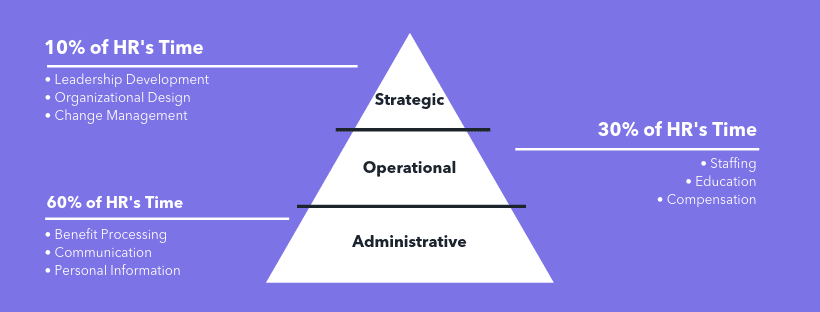Before we explore the basics of HR Management (which we’ll be referring to as HRM) let’s define it first.
HRM comprises the formal systems designed to manage individuals in an organization.
To best understand HRM, we’ll briefly look at the position of HR management, the history, and dive into the role HRM plays in organizations.
Finally, we’ll go over when is the best time to bring a human resources department into the mix and answer the question, ‘how many HR employees do I need?’.
- HR Management Salary
- When did HRM start?
- HR to Employee Ratio 2020 in Businesses
- IS HRM really that important?
What is Human Resource Management & When did HRM start?
Among today’s HR professionals, there appears to be a lack of understanding of the roots of human resources management and how the role of an HR manager became what it is today.
What is now called HRM has evolved a great deal since its beginnings in the 1900s. Personnel departments, which emerged as a defined field by the 1920s across the world, were largely concerned with technical functions.
What began as a primarily clerical process in larger companies, concerned with payroll and employee records, began to face changes following the social legislation of the 1960s.
HRM developed in response to the increase in competitive business organizations in the late 1970s as a result of deregulation and rapid technological change.
In the 1990s, globalization and competition required human resource departments to become more concerned with costs, planning, and the implications of various HR strategies for both organizations and their potential employees.
Prior to this, people may have asked how can human resource management contribute to a company’s success?
As more companies began implementing an HR management system the results were clear. These human resources practices allowed companies to take control of their costs, plan better, and manage their teams more effectively.
HR Management Job Description: How the roles have evolved
The role of HRM professionals has dramatically evolved over the years, and the HR manager job description that once was has taken on a new form.
If an organization chooses to employ a formal HR department, which they should if they are more than 10-15 people, there are typically three different roles that the department may play in the organization. They are as follows:
Strategic
The strategic role forms the link between the human resource staff, the organizational mission, and the work of those in the organization.
Operational
The operational role manages functional human resource activities and serves as an ‘employee champion.’
Administrative
Finally, the administrative role provides recordkeeping, process administration, and compliance efforts, among others. The priority of these roles has changed a lot during the years.

This human resource model provides the context to understand and apply the important role HRM plays in today’s organizations.
These HR functions are a collection of specialized work that is conducted within the department. For each functional area, human resource professionals are responsible for key activities that help the organization move forward.
Now, this begs the question, when is it time to bring HR into the recipe?
For starters, many companies seek out a human resources manager to handle the compensation and benefits of the company’s employees, but then later realize there are countless facets they need to cover, which require much time and attention.
HR Management Salary: Why this matters…
You’ve likely come because you’re asking, ‘how many HR employees do I need?’.
But before diving into anything else, we want to bring out the elephant in the room. Many business owners think they can slip by with having an admin run all of their HR processes.
Although this model may function in smaller companies, don’t forget that companies grow.
Parallel with business growth and more staff are onboarded, it’s crucial that a company creates space in their budget to allow for the HR management salary of a qualified human resources professional.
If you’re the owner of your company and are hiring an HR admin, make sure to put together a proper HR management job description.
Why?
Simply because it will help to ensure you attract the top talents. We’ll cover more of that a bit later.
✔️ Know your role as the human resources manager
If you’re new to the field or are looking for more HR training, it’s always a good idea to brush up on your skills by taking a few courses.
Managing Human Resources: Your HR to Employee Ratio 2020 in Businesses
To dive into the topic, we spoke with Comtravo’s People & Culture manager. We specifically talked about when is the correct time to stir HR into the pot.
The quick answer, better sooner than later.
The well-known general rule “1 position in human resources for every 100 employees” still exists and it’s not bad, but this tends to function for larger companies with a strategic human resources management department that already has sufficient resources.
On one side, there are equations to sustain all of this.
Let’s talk first about calculating the HR to employee ratio 2020 and beyond.
The HR ratio to employees 2020 calculation is determined by dividing the number of HR full-time equivalents by the total number of employees in the organization and multiplying the outcome by 100:
HR to Employee Ratio (Ideal HR Ratio) =
(Total number of HR FTEs / Total number of FTEs) x 100
A Small Business Example: How many HR employees per employee should you have?
Company A has 1 HR FTE employee, 55 FTEs and 15 part-time employees each working 16 hours a week. One part-time employee works 832 hours annually.
The 15 part-time employees collectively work 12,480 hours annually. Calculating the total hours worked is necessary to have the correct numbers for the equation (which uses full-time workers as the variable).
There are 2,080 working hours in the year, and Company A’s part-time staff works 12,480 hours during that year. To calculate FTEs, divide the hours worked (12,480) by the working hours (2,080). The result is 6 FTEs. Add 6 to the 55 FTEs for the total number of FTEs, which is 61.
Plug the numbers into the formula to generate the Employee to HR ratio:
HR-to-Employee Ratio = (1 / 61) x 100
Company A’s HR-to-Employee Ratio = 1.64
A Large Employer Example:
Company B has 5 HR FTEs and 1,000 FTEs. Let’s work out the ratio for that company:
HR-to-Employee Ratio = (5 / 1000) x 100
Company B’s HR-to-Employee Ratio = .5
If you have multiple part-time employees, translate those positions into full-time equivalents for the most accurate results.
Company executives can use the HR-to-employee ratio to know if their company has grown to the point that more HR staff are needed to ensure that employees are effectively managed. Being able to calculate the ratio properly helps business owners make important staffing decisions.
On the other hand, there’s a lot of variations of this method, but they don’t differ a whole lot from each other.
For example, The Society for Human Resource Management’s 2017 Human Capital Benchmarking Study shows that in companies with up to 250 employees, demand is significantly higher, as the study “Workforce Analytics” shows: An average of 3.4 human resources employees per 100 full-time positions in the company! The ideal ratio varies by organizational needs as well.
While roughly two HR staffers per 100 employees may be the norm for many organizations, it may fall short if the organization is undergoing growth and hiring new staff, or is undertaking a significant initiative such as a new training program, new cloud technology, etc.
If the case that your company is in the process of recruitment and selection and doesn’t have the resources to hire more HR staff, it is a good idea to invest in an applicant tracking system such as the one Factorial HR offers, to help manage your recruitment process better.
HR Management Jobs: The Average HR Staff Ratio
The HR Department Benchmarks and Analysis 2017 report issued by Bloomberg and the Bureau of National Affairs indicates that the median HR staff ratio remains at a record high of 1.4 HR employees for every 100 workers served by the department.
Smaller employers generally report higher HR staffing ratios. For larger employers, economies of scale and automation software help them maintain a lower HR-to-employee ratio.
As a result, this ensures they don’t end up hiring on too many HR management jobs than they actually need. While it is possible to calculate the ratio, the ratio by itself does not tell the business owner whether their HR department is able to effectively keep up with demand.
However, being able to calculate the ratio and compare it to other organizations of a similar size is useful for the business owner.
Why?
Well, it helps them evaluate whether the HR departments may be understaffed or overstaffed. These calculations should be evaluated every year as you create your annual HR plan.
IS HRM (HR in Management) really that important?
HR management and Human resources planning to play a strategic role in managing people and the workplace culture and environment.
If effective, it can contribute greatly to the overall company direction and the accomplishment of its goals and objectives.
Nowadays, successful companies need to be adaptive, resilient, customer-centered, and quick to change direction. Within such an environment the effectiveness of HR in management is crucial to business success. Find out when to invest in HRMS Software.
When you establish systems for performance development, career succession planning, and employee growth, employees remain more motivated. Not only that, but they also are happier, personally engaged, and thus contribute to the company’s success.
Even more, the HR professional helps the development of organizational culture and climate in which employees have the competency, concern, and commitment to serve customers well.



Thanks for sharing this valuable information with us. It is really a helpful article!
Nice Blog. Thanks for sharing such great information about the HR Management System.
Glad you enjoyed it Akash!
“A fascinating discussion is definitely worth comment. There’s no doubt that that you ought to publish more on this issue, it may not be a taboo matter but usually people do not talk about such subjects. To the next! All the best!!”
Useful information. Keep Sharing